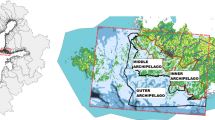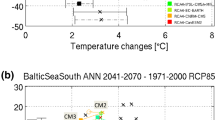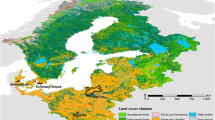Abstract
This paper develops and applies a spatially explicit bioeconomic model to study transboundary nutrient pollution of the Baltic Sea. We combine catchment, marine and economic models covering the entire Baltic Sea region to weigh the costs of nutrient abatement and the benefits of improved water quality and solve for the optimal level of water protection. The overall benefits of the Baltic Sea Action Plan, the present convention on nutrient abatement, clearly outweigh the costs. Nevertheless, the total cost could be almost halved if the mix of measures and the regional targets were planned in a spatially cost–effective manner and if the consequent reductions of nitrogen and phosphorus, the two nutrients causing eutrophication, were better balanced. Policy optimizations, however, suggest that the optimal level of nutrient abatement is somewhat lower than the more ambitious level envisaged by the convention. The welfare gains from cost sharing that makes the optimal level of nutrient abatement worthwhile for all littoral countries would be 170 million euros annually.









Similar content being viewed by others
Notes
Since the first Helsinki Convention in 1974, the littoral countries have agreed to reduce their loads of phosphorus and nitrogen, the main nutrients contributing to plant growth in aquatic ecosystems. The original target of reducing both loads by 50 per cent, defined in the Ministerial Declarations of 1988 and 1990, was never met and was replaced by a revised set of targets in the Baltic Sea Action Plan (BSAP) in 2007.
Biogeochemical marine models combine chemical (e.g. sedimentation of phosphorus), physical (e.g. water exchange) and biological (e.g. nitrogen fixation) processes of the sea in a coherent framework to understand and to make projections of the future evolution of the marine ecosystem.
We focus on the model components that are critical for the purpose of cost–benefit analysis here. More details on the catchment model, cost function and the marine model can be found in Ahlvik et al. (2014) and on the survey eliciting citizens’ WTP for reduced eutrophication in Ahtiainen et al. (2014).
According to the baseline scenario, waterborne nutrient loads will slightly increase during the next 40 years (1 and 4 % of N and P loads, respectively) if the present infrastructure is maintained and no new investments in water protection are made. Nitrogen deposition follows the decreasing trend estimated in EMEP data (BNI 2010); and phosphorus deposition is assumed to be fully correlated to N-deposition and to be 1 % of its value. The time period is assumed to be short enough for climate change not to have a significant effect on nutrient loads.
The analysis can be extended to probabilistic load projections, including seasonal weather-driven variations in the loads. However, yearly variations tend to cancel each other out, making them relatively unimportant over a time horizon of several decades.
Phosphorus in marine sediments is not included as a state variable, but sediment phosphorus release, modeled as a function of phytoplankton biomass, is part of the nutrient accumulation process.
The choice of survey mode was made to ensure representative samples from each country. In Ahtiainen et al. (2012) the Polish data revealed lower WTP in face-to-face interviews than in Internet surveys. However, this observation cannot be generalized to other countries without further study. For example, Lindhjem and Navrud (2011) did not find contingent-valuation-method-based WTP from Internet panel responses to be “less reliable” or “significantly different” from face-to-face responses in Norway.
The survey questions on WTP fulfil the requirements of consequentiality (Carson and Groves 2007). The survey was motivated to the respondents by saying that their “answers would help governments around the Baltic Sea to develop appropriate water quality improvement programs”, implying that their responses would affect whether these programmes would be implemented. In addition, the majority of the respondents cared about reducing eutrophication, and all effects of eutrophication were seen, on average, as problematic.
No reference was made in-text or on the water quality maps to the possible indirect effects in inland waters. This would have blurred our focus on the Baltic Sea and the BSAP as an international agreement. Grey was used for inland areas in the maps. We found the focus well-placed in survey pre-testing.
WTP was also modeled using interval regression, which produced similar parameter and WTP estimates for all countries. The mean WTPs used here are robust to controls for the recreational use of the Baltic Sea (see Ahtiainen et al. 2014).
For complete documentation of the study, see Ahtiainen et al. (2014).
Disaggregation of national benefit estimates was based on a debriefing question that asked “Did you consider the whole Baltic Sea or a certain area of the Baltic Sea when answering how much you were willing to pay?”. The respondents who did not consider the entire sea were then asked to specify: “Which area(s) of the Baltic Sea did you have in mind when answering how much you were willing to pay? You may choose one or several areas.”
The choice of interest rate is often decisive when evaluating long-term environmental investments, with a lower rate tending to favour measures with long lags (Nordhaus 2007). Here, a 3.5 per cent real rate of interest was chosen for discounting to accord with the rates typically used for evaluating public projects (e.g. Treasury 2003)
The respondents were asked “Which of the effects of eutrophication did you have in mind when answering how much you were willing to pay? You may choose one or several alternatives. (i) Water turbidity, (ii) blue-green algal blooms, (iii) underwater meadows loss, (iv) fish species composition changes, (v) lack of oxygen in deep sea bottom areas”.
For example, the upper limits imposed on the reductions in the numbers of production animals ensured that national food security requirements would be fulfilled.
Nutrient abatement improves the quality of inland waters and some of the measures, such as establishing wetlands, may enhance the biodiversity of agricultural lands and the scenic value of the landscape.
Table 1a presents the initial loads, baseline development and targets for the five policy goals.
In our model, primary production in all the sea basins except for the Bothnian Bay are nitrogen-limited.
Note that identification of new low-cost abatement measures depends on the choice of policy instruments and incentives created for farmers and industries to improve nutrient abatement technologies.
References
Acemoglu D, Robinson JA (2013) Economics versus politics: pitfalls of policy advice. J Econ Perspectives 27:173–192
Aftab A, Hanley N, Kampas A (2007) Co-ordinated regulation: controlling non-point nitrate pollution while maintaining river flows. Environ Resour Econ 38:573–593
Ahlvik L, Ekholm P, Hyytiäinen K, Pitkänen H (2014) An economic–ecological model to evaluate impacts of nutrient abatement in the Baltic Sea. Environm Modell Softw 55:164–175
Ahlvik L, Pavlova Y (2013) A strategic analysis of eutrophication abatement in the Baltic Sea. Environ Resour Econ 56:353–378
Ahtiainen H, Artell J, Czajkowski M et al (2014) Benefits of meeting nutrient reduction targets for the Baltic Sea—a contingent valuation study in the nine coastal states. J Environ Econ Policy. doi:10.1080/21606544.2014.901923
Ahtiainen H, Hasselström L, Artell J et al (2012) Benefits of meeting the Baltic Sea nutrient reduction targets—combining ecological modelling and contingent valuation in the nine littoral states. MTT Discussion Papers 1/2012. http://www.mtt.fi/dp/DP2012_1.pdf
Andersen JH, Axe P, Backer H et al (2011) Getting the measure of eutrophication in the Baltic Sea: towards improved assessment principles and methods. Biogeochemistry 106:137–156
Batabyal AA, Kahn J, O’Neill RV (2003) On the scarcity value of ecosystem services. J Environ Econ Manag 46:334–352
Bateman IJ, Carson RT, Day B et al (2002) Economic valuation with stated preference techniques: a manual. Edward Elgar Publishing, Cheltenham
Baltic Nest Institute (2010) Marine research on eutrophication. http://nest.su.se/nest/ (viewed 1.12.2010)
Brady M (2002) Stochastic arable-nitrogen abatement from heterogeneous sources—cost–effective coastal nitrogen abatement. Paper presented to world congress of environmental and resource economics in Monterey, California, June 2002
Carpenter SR (2005) Eutrophication of aquatic ecosystems: bistability and soil phosphorus. Proc Natl Acad Sci 102:10002–10005
Carson RT, Groves T (2007) Incentive and informational properties of preference questions. Environ Resour Econ 37:181–210
Chen Y, Jayaprakash C, Irwin E (2012) Threshold management in a coupled economic–ecological system. J Environ Econ Manag 64:442–455
Conley DJ, Paerl HW, Howarth R et al (2009) Controlling eutrophication: nitrogen and phosphorus. Science 323:1014–1015
Dillman D, Smyth J, Christian L (2009) Internet, mail and mixed-mode surveys: the tailored design method, 3rd edn. Wiley, Hoboken
Elofsson K (2003) Cost–effective reductions of stochastic agricultural loads to the Baltic Sea. Ecol Econ 47:13–31
Elofsson K (2010) Cost–effectiveness of the Baltic Sea Action Plan. Mar Policy 34:1043–1050
Gren I-M (2008) Cost effectiveness and fairness of the HELCOM Baltic Sea Action Plan against eutrophication. Vatten 64:273–281
Gren I-M, Elofsson K, Jannke P (1997a) Cost–effective nutrient reductions to the Baltic Sea. Environ Resour Econ 10:341–362
Gren I-M, Söderqvist T, Wulff F (1997b) Nutrient reductions to the Baltic Sea: ecology, costs and benefits. J Environ Manag 51:123–143
HELCOM (2007) HELCOM Baltic Sea Action Plan. HELCOM ministerial meeting in Krakow, Poland, 15 November 2007
HELCOM (2011) Fifth Baltic Sea pollution load compilation (PLC-5). Baltic Sea environment proceedings no. 128, p 218
HM Treasury (2003) The green book. Appraisal and evaluation in central government. https://www.gov.uk/government/uploads/system/uploads/attachment_data/file/179349/green_book_complete.pdf
Kiirikki M, Lehtoranta J, Inkala A et al (2006) A simple sediment process description suitable for 3D-ecosystem modeling—development and testing in the Gulf of Finland. J Mar Syst 61:55–66
Kiseleva T, Wagener FOO (2010) Bifurcations of optimal vector fields in the shallow lake model. J Econ Dyn Control 34:825–843
Kondratev SA (2011) Estimation of the nutrient load on the Gulf of Finland from the Russian part of its catchment. Water Resour 38:63–71
Laukkanen M, Huhtala A (2008) Optimal management of a eutrophied coastal ecosystem: balancing agricultural and municipal abatement measures. Environ Resour Econ 39:139–159
Larsen HG (2008) Scaling the Baltic Sea environment. Geoforum 39:2000–2008
Lindhjem H, Navrud S (2011) Are internet surveys an alternative to face-to-face interviews in contingent valuation? Ecol Econ 70:1628–1637
Lindhjem H, Navrud S (2008) How reliable are meta-analyses for international benefit transfers? Ecol Econ 66:425–435
Luenberger DG (1992) Benefit functions and duality. J Math Econ 21:461–481
Maar M, Friis Møller E, Larsen J et al (2011) Ecosystem modeling across a salinity gradient from the North Sea to the Baltic Sea. Ecol Model 222:1696–1711
Markowska A, Źylicz T (1999) Costing an international public good: the case of the Baltic Sea. Ecol Econ 30:301–316
Massey DM, Newbold SC, Gentner B et al (2006) Valuing water quality changes using a bioeconomic model of a coastal recreational fishery. J Environ Econ Manag 52:482–500
Mäler K-G, Xapapadeas A, de Zeeuw A (2003) The economics of shallow lakes. Environ Resour Econ 26:603–624
Nordhaus WD (1993) Rolling the ‘DICE’: an optimal transition path for controlling greenhouse gases. Resour Energy Econ 15:27–50
Nordhaus WD (2007) A review of the Stern review on the economics of climate change. J Econ Lit 45:703–724
Paerl HW, Xu H, McCarthy MJ, Zhu G, Qin B, Li Y, Gardner WS (2011) Controlling harmful cyanobacterial blooms in a hyper-eutrophic lake (Lake Taihu, China): the need for a dual nutrient (N & P) management strategy. Water Res 45:1973–1983
Pindyck RS (2013) Climate change policy: what do the models tell us? J Econ Lit 51:860–872
Portney PR (2004) The obligations of a policy economist. Agric Resour Econ Rev 33:159–161
Sanchirico JN, Wilen JE (2005) Optimal spatial management of renewable resources: matching policy scope to ecosystem scale. J Environ Econ Manag 50:23–46
Schindler DW, Hecky RE, Findlay DL, Stainton MP, Parker BR, Paterson MJ, Beauty KG, Lyng M, Kasian SEM (2008) Eutrophication of lakes cannot be controlled by reducing nitrogen input: results of a 37-year whole-ecosystem experiment. Proc Natl Acad Sci 105:11254–11258
Schindler DW (2012) The dilemma of controlling cultural eutrophication of lakes. Proc R Soc B 279:4322–4333
Scott JT, McCarthy MJ (2010) Nitrogen fixation may not balance the nitrogen pool in lakes over timescales relevant to eutrophication management. Limnol Oceanogr 55:1265–1270
Smith MD, Sanchirico JN, Wilen JE (2009) The economics of spatial–dynamic processes: applications to renewable resources. J Environ Econ Manag 57:104–121
Stern N (2007) The economics of climate change: the Stern review. Cambridge University Press, Cambridge
Tol RSJ (2001) Equitable cost–benefit analysis of climate change policies. Ecol Econ 36:71–85
Turner RK, Georgiou S, Gren I-M et al (1999) Managing nutrient fluxes and pollution in the Baltic: an interdisciplinary simulation study. Ecol Econ 30:333–352
Turner RK, Morse-Jones S, Fisher B (2010) Ecosystem valuation: a sequential decision support system and quality assessment issues. Ann N Y Acad Sci 1185:79–101
Weyant JP, Davidson O, Dowlatabadi H et al (1996) Integrated assessment of climate change: an overview and comparison of approaches and results. In: Bruce JB, Lee H, Haites EF (eds) Climate change 1995: economic and social dimensions. Cambridge University Press, Cambridge, pp 367–396
Acknowledgments
This research was conducted as part of the project “Protection of the Baltic Sea: Benefits, Costs and Policy Instruments”, financed by the Finnish Advisory Board of Sectoral Research, and as part of the BalticSTERN research network. We are grateful to the following organizations and projects for collaboration: “Managing Baltic nutrients in relation to cyanobacterial blooms: what should we aim for?”, funded by the Swedish Research Council for Environment, Agricultural Sciences and Spatial Planning; “Integrated management of agriculture, fishery, environment and economy,” funded by the Danish Strategic Research Council; The Baltic Nest Institute—Aarhus University; the BalticSTERN Secretariat at the Stockholm Resilience Centre, Stockholm University; the German Federal Environment Agency; and the Swedish Environmental Protection Agency. We are grateful to Mike Elliot, Vivi Fleming-Lehtinen, Risto Lignell and Kerry Turner for helpful discussions and comments and Richard Foley for the English language revision.
Author information
Authors and Affiliations
Corresponding author
Appendix
Appendix
See Table 5.
Rights and permissions
About this article
Cite this article
Hyytiäinen, K., Ahlvik, L., Ahtiainen, H. et al. Policy Goals for Improved Water Quality in the Baltic Sea: When do the Benefits Outweigh the Costs?. Environ Resource Econ 61, 217–241 (2015). https://doi.org/10.1007/s10640-014-9790-z
Accepted:
Published:
Issue Date:
DOI: https://doi.org/10.1007/s10640-014-9790-z




